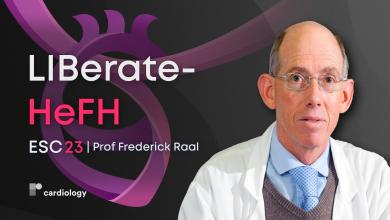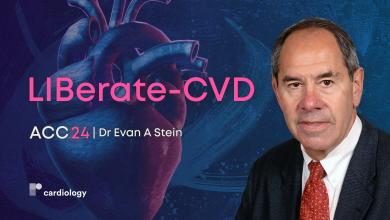Search results
Author(s):
Shane Prejean
,
Todd M Brown
Added:
3 years ago
Proprotein convertases are proteolytic enzymes that activate proteins by post-translational alterations in protein structure. Proprotein convertase subtilisin/kexin 9 (PCSK9) is a proprotein convertase that binds and inactivates the low-density lipoprotein (LDL) receptor on the surface of hepatocytes resulting in higher levels of serum LDL cholesterol (LDL-C).1 Over-expression of PCSK9 leads to a…
View more
Author(s):
Frederick Raal
Added:
7 months ago
ESC 23 — Prof Frederick Raal (University of the Witwatersrand, Johannesburg, SA) outlines the late-breaking results from the LIBerte-HeFH study (NCT04797104).
The phase III LIBerte-HeFH study (LIB Therapeutics LLC) aimed to assess the effectiveness of PCSK9-inhibitor Ierodalcibep (LIB003) in reducing low-density lipoprotein cholesterol (LDL-C) in 300mg doses administered subcutaneously in…
View more
Author(s):
Evan A Stein
Added:
1 week ago
ACC.24 — We are joined onsite by investigator, Dr Evan A Stein (Medpace Reference Laboratories, US) to discuss the findings from the LIBerate-CVD trial (NCT04797247).LIBerate-CVD investigated LDL-C reductions in a cohort of 900 patients with cardiovascular diseases and hyper-LDL-cholesterol treated with 300mg subcutaneous Lerodalcibep as compared to placebo across a 52-week treatment period…
View more
Author(s):
Evan A Stein
Added:
3 years ago
Proprotein convertase subtilisin/kexin type 9 (PCSK9), discovered in 2003, is a circulating protein produced predominantly in the liver that plays a significant role in the recycling of LDL receptors (LDLRs).1,2 The LDLR, which normally recycles about 100 times in its lifetime, is the primary pathway for LDL-cholesterol (LDL-C) clearance from circulation. Plasma PCSK9 binds to LDLRs along with…
View more
Author(s):
Jiaqian Xu
,
Michael D Shapiro
Added:
3 years ago
Author(s):
Leo Buckley
,
Ahmed Aldemerdash
Added:
3 years ago
Cardiovascular disease is the leading cause of death in the US.1,2 Although advances in the prevention and treatment of cardiovascular disease have contributed to a decline in mortality rates, this favorable trend has slowed over the past several years.3 Recently, however, a revival of cardiovascular drug development has introduced new treatment options to the market, with several promising…
View more
Author(s):
Paul M Ridker
Added:
2 years ago
In this video, Dr Paul Ridker (Brigham and Women’s Hospital, Boston, MA, US) discusses the findings from the RESCUE trial, which aimed to assess whether Ziltivekimab is effective in reducing cardiovascular biomarkers in high-risk patients with chronic kidney disease. Dr Ridker also outlines the upcoming ZEUS outcomes study following the results of this trial.
Questions:
1. What does this trial…
View more
Author(s):
Katelyn Storey
,
Scott W Sharkey
Added:
3 years ago
During the past 25 years, takotsubo syndrome (TS) has emerged as an important form of acute myocardial injury characterized by a distinctive regional left ventricular (LV) contraction abnormality, often with marked reduction of the LV ejection fraction, and typically completely reversible. At presentation, TS is often indistinguishable from acute coronary syndrome, yet its occurrence is…
View more
Author(s):
Aarti Asnani
,
Randall T Peterson
Added:
3 years ago
Survival rates among patients diagnosed with cancer have improved dramatically over the past few decades. In 2016, there were an estimated 16 million cancer survivors in the United States, a number expected to increase to 20 million over the subsequent decade.1 One-third of these patients will survive at least 5 years after their initial cancer diagnosis, largely due to cancer therapies that are…
View more
Amyloid Heart Disease
Author(s):
Yaser Nemshah
,
Alex Clavijo
,
Gyanendra Sharma
Added:
3 years ago
Article














